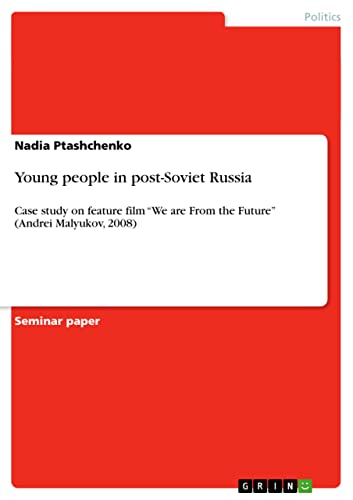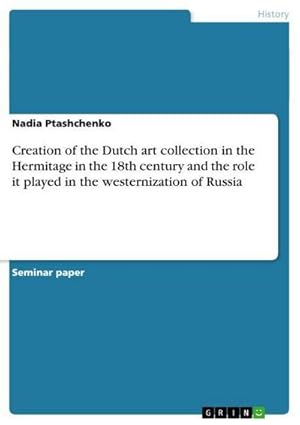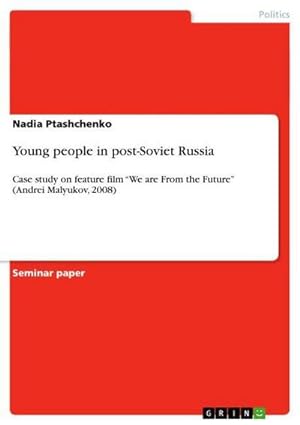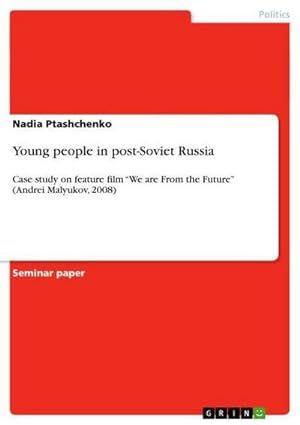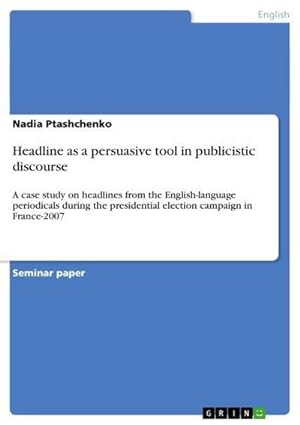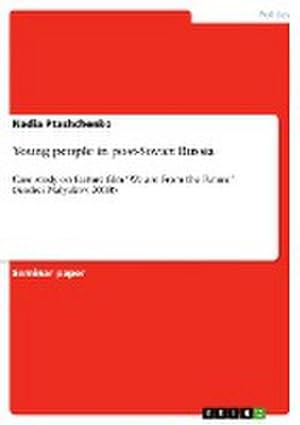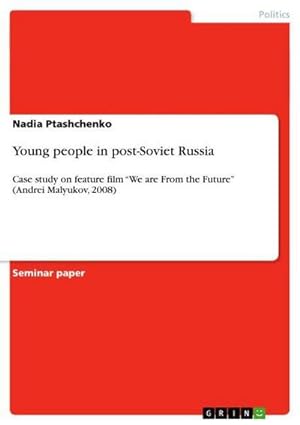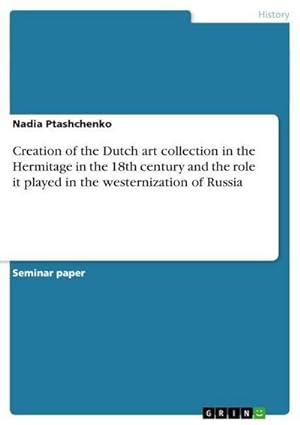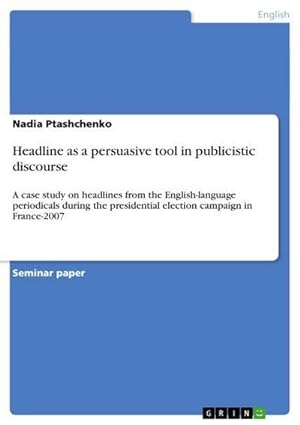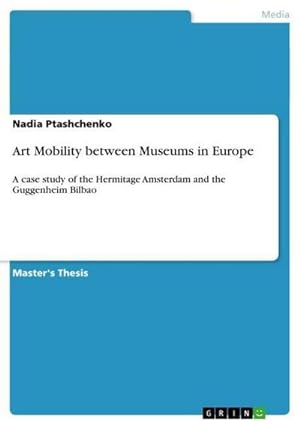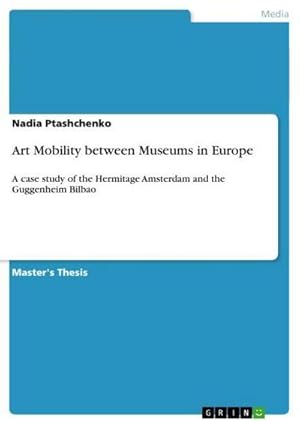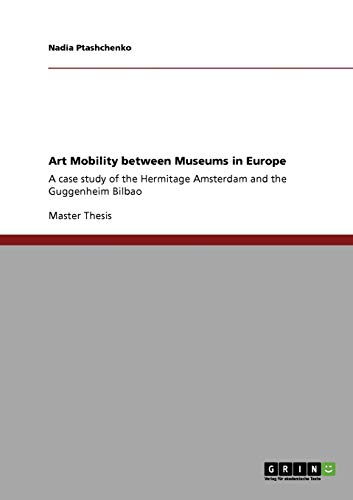nadia ptashchenko (14 résultats)
Type d'article
- Tous les types d'articles
- Livres (14)
- Magazines & Périodiques
- Bandes dessinées
- Partitions de musique
- Art, Affiches et Gravures
- Photographies
- Cartes
-
Manuscrits &
Papiers anciens
Etat
Reliure
- Toutes
- Couverture rigide
- Couverture souple
Particularités
- Edition originale
- Signé
- Jaquette
- Avec images (10)
- Sans impression à la demande (11)
Pays
Evaluation du vendeur
-
Young people in postSoviet Russia Case study on feature film We are From the Future Andrei Malyukov, 2008
Edité par Grin Publishing, 2009
ISBN 10 : 3640398750ISBN 13 : 9783640398751
Vendeur : PBShop.store US, Wood Dale, IL, Etats-Unis
Livre
PAP. Etat : New. New Book. Shipped from UK. Established seller since 2000.
-
Young people in post-Soviet Russia: Case study on feature film "We are From the Future" (Andrei Malyukov, 2008)
Edité par GRIN Publishing, 2009
ISBN 10 : 3640398750ISBN 13 : 9783640398751
Vendeur : Revaluation Books, Exeter, Royaume-Uni
Livre
Paperback. Etat : Brand New. 36 pages. 10.00x7.00x0.09 inches. In Stock.
-
Creation of the Dutch art collection in the Hermitage in the 18th century and the role it played in the westernization of Russia
Edité par GRIN Verlag Aug 2009, 2009
ISBN 10 : 3640397983ISBN 13 : 9783640397983
Vendeur : BuchWeltWeit Ludwig Meier e.K., Bergisch Gladbach, Allemagne
Livre impression à la demande
Taschenbuch. Etat : Neu. This item is printed on demand - it takes 3-4 days longer - Neuware -Seminar paper from the year 2008 in the subject History Europe - Other Countries - Modern Times, Absolutism, Industrialization, grade: ECTS 8, University of Groningen, course: M.A. 'Euroculture', language: English, abstract: This paper attempts to follow the cultural channels and actual steps taken by Peter the Great and his successors to cultivate Western European tastes in Russia and to direct the Russian Empire to a Western path of development. It investigates the historic role of St. Petersburg as Russia's 'window on Europe', and features the great masterworks of Western European art (namely, Dutch) assembled and prized in the Hermitage by the Romanov dynasty, by Peter the Great and by his spiritual follower and enlightener - Catherine the Great, in particular.Over the course of centuries, Russian tsars continuously borrowed ideas and concepts from their Western neighbors. St. Petersburg was to mark the way for Russia to become modern by creating an environment that could be maintained only by broader and deeper contact with the West. However, Peter Rietbergen in his essay on 'Russia between West and East' stresses 'the inherent duality in Russian culture, and in the national character, as half-Asian, half-European'. This issue is to be discussed and evaluated in the paper. A chronological overview of the main acquisitions of Dutch paintings to the Hermitage in the course of the XVIII century is included in the paper. It is hoped that the paper will add to the understanding of the described epoch of the Russian Empire and will expose the role it played in defining its path of historical development.The thesis statement investigated in the paper is as follows: 'Has the borrowing of cultural values from Western Europe contributed to the Europeanization of Russia in the XVIII century ' Under the term 'cultural values' artefacts, objects of art, enlightening ideas and books, as well as progressive reforms, European fashion and lifestyle, etc are implied. One of the aims of the research is to demonstrate that art which has been broadly studied from divergent viewpoints of style, content, iconography, philosophy, and the social sciences, can also be approached as a function of economic and socio-political motives. A method of comparative analysis of the Westernizing cultural policies by Peter I and later, by Catherine II is used. 16 pp. Englisch.
-
Young people in post-Soviet Russia
Edité par GRIN Verlag Aug 2009, 2009
ISBN 10 : 3640398750ISBN 13 : 9783640398751
Vendeur : BuchWeltWeit Ludwig Meier e.K., Bergisch Gladbach, Allemagne
Livre
Taschenbuch. Etat : Neu. Neuware -Seminar paper from the year 2008 in the subject Politics - International Politics - Region: Russia, grade: 7, Uppsala University, course: M.A. 'Euroculture: Europe in the Wider World', language: English, abstract: During the course of the twentieth century, the Soviet Union rose and fell, and Russia re-emerged. The Russians were left 'feeling robbed of a sense of place, of purpose and of identity' . By the mid-1990's, Russia, while contending with the ups and downs of economic crisis and the health of its leaders, was trying to find its own course, attempting to resurrect past glories, learn from recent mistakes, and forge a place in a community of nations. Together with society, youth was going through a period of change in its ideological, economic and moral values. According to Martha Olcott, 'it was Russian youth, who seemed to suffer disproportionately from the numerous social disorders in the USSR at the end of the decade'. Ilynsky talks about the widespread moral decay in Russia in the 1990's and the lack of direction among many young people - 'their poor understanding of freedom, lack of faith in politicians, growing sense of injustice and general concerns about what the future might bring'. Russian identity is and has been a topic of continual argument, of conflicting claims, competing images, contradictory criteria. According to S. Franklin, 'Russia is continually represented as a question, a field of possibilities, a set of contradictions'. After the collapse of the Soviet Union in 1991 even more intensified self-questioning in the 'new' Russia started. Usually, such questions have been posed by the young population of Russia who happened to live in the period of global economic and ideological transitions. What kind of country is Russia to be What has happened to young people in the post-Communist phase The focus of this paper is how the changing economic, political and social geography of Russia affected the youth since the fall of communism in 1991. I will reflect upon the typical portrait and particular features of the post-Soviet youth. My research question is as follow: 'What images, sentiments, and obligations do young Russians attribute to their homeland, and how do these contribute to an understanding of their notions of ethnicity, patriotism, and nationalism ' 20 pp. Englisch.
-
Young people in post-Soviet Russia
Edité par GRIN Verlag Aug 2009, 2009
ISBN 10 : 3640398750ISBN 13 : 9783640398751
Vendeur : Rheinberg-Buch Andreas Meier eK, Bergisch Gladbach, Allemagne
Livre
Taschenbuch. Etat : Neu. Neuware -Seminar paper from the year 2008 in the subject Politics - International Politics - Region: Russia, grade: 7, Uppsala University, course: M.A. 'Euroculture: Europe in the Wider World', language: English, abstract: During the course of the twentieth century, the Soviet Union rose and fell, and Russia re-emerged. The Russians were left 'feeling robbed of a sense of place, of purpose and of identity' . By the mid-1990's, Russia, while contending with the ups and downs of economic crisis and the health of its leaders, was trying to find its own course, attempting to resurrect past glories, learn from recent mistakes, and forge a place in a community of nations. Together with society, youth was going through a period of change in its ideological, economic and moral values. According to Martha Olcott, 'it was Russian youth, who seemed to suffer disproportionately from the numerous social disorders in the USSR at the end of the decade'. Ilynsky talks about the widespread moral decay in Russia in the 1990's and the lack of direction among many young people - 'their poor understanding of freedom, lack of faith in politicians, growing sense of injustice and general concerns about what the future might bring'. Russian identity is and has been a topic of continual argument, of conflicting claims, competing images, contradictory criteria. According to S. Franklin, 'Russia is continually represented as a question, a field of possibilities, a set of contradictions'. After the collapse of the Soviet Union in 1991 even more intensified self-questioning in the 'new' Russia started. Usually, such questions have been posed by the young population of Russia who happened to live in the period of global economic and ideological transitions. What kind of country is Russia to be What has happened to young people in the post-Communist phase The focus of this paper is how the changing economic, political and social geography of Russia affected the youth since the fall of communism in 1991. I will reflect upon the typical portrait and particular features of the post-Soviet youth. My research question is as follow: 'What images, sentiments, and obligations do young Russians attribute to their homeland, and how do these contribute to an understanding of their notions of ethnicity, patriotism, and nationalism ' 20 pp. Englisch.
-
Headline as a persuasive tool in publicistic discourse
Edité par GRIN Verlag Aug 2009, 2009
ISBN 10 : 3640398025ISBN 13 : 9783640398027
Vendeur : BuchWeltWeit Ludwig Meier e.K., Bergisch Gladbach, Allemagne
Livre impression à la demande
Taschenbuch. Etat : Neu. This item is printed on demand - it takes 3-4 days longer - Neuware -Seminar paper from the year 2008 in the subject English Language and Literature Studies - Linguistics, grade: 8 ECTS (out of 10), University of Groningen, course: M.A. 'Euroculture: Europe in the Wider World', language: English, abstract: In this paper the headline of English-speaking newspapers and magazines has been studied as an independent and effective persuasive element of a text. In this paper I want to discuss, how susceptible are we to linguistic style How profoundly can the impact of a message be enhanced by the manner in which it is written, assuming that one and the same thought can be expressed with different stylistic tools The choice of words reflects not only differences in evaluations (positive or negative) or in emotions - it is also able to thrust reader's attitude to the core of a message and to direct and control one's perception and comprehension. The paper claims that language can be a very powerful and persuasive tool which draws the readers' attention, being operated by skilful editors in a newspaper or magazine headline. In this regard, the purpose of the paper is to address and answer the research question: 'How persuasion is realized linguistically across the English-speaking newspaper and magazine headlines 'The study of headline as a powerful and persuasive linguistic tool can be applicable to multiple spheres of public life and to various media of information (e.g.: political campaigns, slogans, advertising, publication of new directives issued by the European Commission, etc.). It is interesting to observe, what kind of stylistic devices and persuasive techniques news editors apply in headlines during the election campaigns in France (in 2007), in order to create public opinion or to provoke a certain reaction from the readers.Periodicals are cultural artefacts which are created and which function within a certain cultural context. That is, they operate within the value system of that culture. Schäffner noted that 'any political action is prepared, accompanied, controlled and influenced by language' . According to M. Foucault , who first introduced aspect of power in construction of meaning, things have no meaning in themselves, they gain meaning which varies from context to context. All cultural practices depend on meaning and are constructed within discourse. Consequently, language is not simply a medium carrying meaning, but a medium constructing meaning. This paper argues that a headline in newspapers and magazines holds a persuasive potential and is able to direct construction of a certain context for interpreting and affecting reader's emotions. It gives grounds for claiming that same facts can be interpreted differently in different contexts. 24 pp. Englisch.
-
Young people in post-Soviet Russia
Edité par GRIN Verlag Aug 2009, 2009
ISBN 10 : 3640398750ISBN 13 : 9783640398751
Vendeur : Wegmann1855, Zwiesel, Allemagne
Livre
Taschenbuch. Etat : Neu. Neuware -Seminar paper from the year 2008 in the subject Politics - International Politics - Region: Russia, grade: 7, Uppsala University, course: M.A. 'Euroculture: Europe in the Wider World', language: English, abstract: During the course of the twentieth century, the Soviet Union rose and fell, and Russia re-emerged. The Russians were left 'feeling robbed of a sense of place, of purpose and of identity' . By the mid-1990's, Russia, while contending with the ups and downs of economic crisis and the health of its leaders, was trying to find its own course, attempting to resurrect past glories, learn from recent mistakes, and forge a place in a community of nations. Together with society, youth was going through a period of change in its ideological, economic and moral values. According to Martha Olcott, 'it was Russian youth, who seemed to suffer disproportionately from the numerous social disorders in the USSR at the end of the decade'. Ilynsky talks about the widespread moral decay in Russia in the 1990's and the lack of direction among many young people - 'their poor understanding of freedom, lack of faith in politicians, growing sense of injustice and general concerns about what the future might bring'. Russian identity is and has been a topic of continual argument, of conflicting claims, competing images, contradictory criteria. According to S. Franklin, 'Russia is continually represented as a question, a field of possibilities, a set of contradictions'. After the collapse of the Soviet Union in 1991 even more intensified self-questioning in the 'new' Russia started. Usually, such questions have been posed by the young population of Russia who happened to live in the period of global economic and ideological transitions. What kind of country is Russia to be What has happened to young people in the post-Communist phase The focus of this paper is how the changing economic, political and social geography of Russia affected the youth since the fall of communism in 1991. I will reflect upon the typical portrait and particular features of the post-Soviet youth. My research question is as follow: 'What images, sentiments, and obligations do young Russians attribute to their homeland, and how do these contribute to an understanding of their notions of ethnicity, patriotism, and nationalism ' 20 pp. Englisch.
-
Young people in postSoviet Russia Case study on feature film We are From the Future Andrei Malyukov, 2008
Edité par Grin Publishing, 2009
ISBN 10 : 3640398750ISBN 13 : 9783640398751
Vendeur : PBShop.store UK, Fairford, GLOS, Royaume-Uni
Livre
PAP. Etat : New. New Book. Shipped from UK. Established seller since 2000.
-
Young people in post-Soviet Russia : Case study on feature film ¿We are From the Future¿ (Andrei Malyukov, 2008)
Edité par GRIN Verlag Aug 2009, 2009
ISBN 10 : 3640398750ISBN 13 : 9783640398751
Vendeur : AHA-BUCH GmbH, Einbeck, Allemagne
Livre
Taschenbuch. Etat : Neu. Neuware - Seminar paper from the year 2008 in the subject Politics - International Politics - Region: Russia, grade: 7, Uppsala University, course: M.A. 'Euroculture: Europe in the Wider World', language: English, abstract: During the course of the twentieth century, the Soviet Union rose and fell, and Russia re-emerged. The Russians were left 'feeling robbed of a sense of place, of purpose and of identity' . By the mid-1990's, Russia, while contending with the ups and downs of economic crisis and the health of its leaders, was trying to find its own course, attempting to resurrect past glories, learn from recent mistakes, and forge a place in a community of nations. Together with society, youth was going through a period of change in its ideological, economic and moral values. According to Martha Olcott, 'it was Russian youth, who seemed to suffer disproportionately from the numerous social disorders in the USSR at the end of the decade'. Ilynsky talks about the widespread moral decay in Russia in the 1990's and the lack of direction among many young people - 'their poor understanding of freedom, lack of faith in politicians, growing sense of injustice and general concerns about what the future might bring'. Russian identity is and has been a topic of continual argument, of conflicting claims, competing images, contradictory criteria. According to S. Franklin, 'Russia is continually represented as a question, a field of possibilities, a set of contradictions'. After the collapse of the Soviet Union in 1991 even more intensified self-questioning in the 'new' Russia started. Usually, such questions have been posed by the young population of Russia who happened to live in the period of global economic and ideological transitions. What kind of country is Russia to be What has happened to young people in the post-Communist phase The focus of this paper is how the changing economic, political and social geography of Russia affected the youth since the fall of communism in 1991. I will reflect upon the typical portrait and particular features of the post-Soviet youth. My research question is as follow: 'What images, sentiments, and obligations do young Russians attribute to their homeland, and how do these contribute to an understanding of their notions of ethnicity, patriotism, and nationalism '.
-
Creation of the Dutch art collection in the Hermitage in the 18th century and the role it played in the westernization of Russia
Edité par GRIN Verlag, 2009
ISBN 10 : 3640397983ISBN 13 : 9783640397983
Vendeur : AHA-BUCH GmbH, Einbeck, Allemagne
Livre
Taschenbuch. Etat : Neu. Druck auf Anfrage Neuware - Printed after ordering - Seminar paper from the year 2008 in the subject History Europe - Other Countries - Modern Times, Absolutism, Industrialization, grade: ECTS 8, University of Groningen, course: M.A. 'Euroculture', language: English, abstract: This paper attempts to follow the cultural channels and actual steps taken by Peter the Great and his successors to cultivate Western European tastes in Russia and to direct the Russian Empire to a Western path of development. It investigates the historic role of St. Petersburg as Russia's 'window on Europe', and features the great masterworks of Western European art (namely, Dutch) assembled and prized in the Hermitage by the Romanov dynasty, by Peter the Great and by his spiritual follower and enlightener - Catherine the Great, in particular.Over the course of centuries, Russian tsars continuously borrowed ideas and concepts from their Western neighbors. St. Petersburg was to mark the way for Russia to become modern by creating an environment that could be maintained only by broader and deeper contact with the West. However, Peter Rietbergen in his essay on 'Russia between West and East' stresses 'the inherent duality in Russian culture, and in the national character, as half-Asian, half-European'. This issue is to be discussed and evaluated in the paper. A chronological overview of the main acquisitions of Dutch paintings to the Hermitage in the course of the XVIII century is included in the paper. It is hoped that the paper will add to the understanding of the described epoch of the Russian Empire and will expose the role it played in defining its path of historical development.The thesis statement investigated in the paper is as follows: 'Has the borrowing of cultural values from Western Europe contributed to the Europeanization of Russia in the XVIII century ' Under the term 'cultural values' artefacts, objects of art, enlightening ideas and books, as well as progressive reforms, European fashion and lifestyle, etc are implied. One of the aims of the research is to demonstrate that art which has been broadly studied from divergent viewpoints of style, content, iconography, philosophy, and the social sciences, can also be approached as a function of economic and socio-political motives. A method of comparative analysis of the Westernizing cultural policies by Peter I and later, by Catherine II is used.
-
Headline as a persuasive tool in publicistic discourse : A case study on headlines from the English-language periodicals during the presidential election campaign in France-2007
Edité par GRIN Verlag, 2009
ISBN 10 : 3640398025ISBN 13 : 9783640398027
Vendeur : AHA-BUCH GmbH, Einbeck, Allemagne
Livre
Taschenbuch. Etat : Neu. Druck auf Anfrage Neuware - Printed after ordering - Seminar paper from the year 2008 in the subject English Language and Literature Studies - Linguistics, grade: 8 ECTS (out of 10), University of Groningen, course: M.A. 'Euroculture: Europe in the Wider World', language: English, abstract: In this paper the headline of English-speaking newspapers and magazines has been studied as an independent and effective persuasive element of a text. In this paper I want to discuss, how susceptible are we to linguistic style How profoundly can the impact of a message be enhanced by the manner in which it is written, assuming that one and the same thought can be expressed with different stylistic tools The choice of words reflects not only differences in evaluations (positive or negative) or in emotions - it is also able to thrust reader's attitude to the core of a message and to direct and control one's perception and comprehension. The paper claims that language can be a very powerful and persuasive tool which draws the readers' attention, being operated by skilful editors in a newspaper or magazine headline. In this regard, the purpose of the paper is to address and answer the research question: 'How persuasion is realized linguistically across the English-speaking newspaper and magazine headlines 'The study of headline as a powerful and persuasive linguistic tool can be applicable to multiple spheres of public life and to various media of information (e.g.: political campaigns, slogans, advertising, publication of new directives issued by the European Commission, etc.). It is interesting to observe, what kind of stylistic devices and persuasive techniques news editors apply in headlines during the election campaigns in France (in 2007), in order to create public opinion or to provoke a certain reaction from the readers.Periodicals are cultural artefacts which are created and which function within a certain cultural context. That is, they operate within the value system of that culture. Schäffner noted that 'any political action is prepared, accompanied, controlled and influenced by language' . According to M. Foucault , who first introduced aspect of power in construction of meaning, things have no meaning in themselves, they gain meaning which varies from context to context. All cultural practices depend on meaning and are constructed within discourse. Consequently, language is not simply a medium carrying meaning, but a medium constructing meaning. This paper argues that a headline in newspapers and magazines holds a persuasive potential and is able to direct construction of a certain context for interpreting and affecting reader's emotions. It gives grounds for claiming that same facts can be interpreted differently in different contexts.
-
Art Mobility between Museums in Europe
Edité par GRIN Verlag Jul 2009, 2009
ISBN 10 : 3640368517ISBN 13 : 9783640368518
Vendeur : BuchWeltWeit Ludwig Meier e.K., Bergisch Gladbach, Allemagne
Livre impression à la demande
Taschenbuch. Etat : Neu. This item is printed on demand - it takes 3-4 days longer - Neuware -Master's Thesis from the year 2009 in the subject Art - Miscellaneous, grade: B (ECTS), 8 out of 10, University of Groningen, course: Double-Degree Erasmus Mundus Master Course 'Euroculture: Europe in the Wider World', language: English, abstract: Beginning with the last decades of the 20th century it has been an unprecedented tendency to create outposts of big museums abroad. The opening of the Hermitage-Guggenheim Exhibition Centre in Las Vegas and the decision of creating a filial branch of the Louvre in Abu-Dhabi in 2012 can serve as an illustrative example of this phenomenon.The purpose of the present Master Thesis is to show that despite political, economic and linguistic diversities that exist between the Netherlands and Russia, strong cultural ties and cross-cultural dialogues have remained since the 18th century and areflourishing nowadays. I will demonstrate what has been done in practice in order to strengthen international cross-cultural bonds and to introduce foreign cultural heritage abroad in particular.The aim of the Master Thesis is to study the examples of museum models in the 21st century illustrated by the case study of the Hermitage Amsterdam Complex and the Guggenheim Bilbao Museum 'satellite' museums. Taking into account the importanceand special significance of the latter, the choice of that particular case study seems rational and illustrative. I will present the motives and goals of 'expansion' tendenciesof large art museums in the Netherlands and in Spain. I will elaborate on difference in motives beyond the opening of museums' outposts by Russian and by American museums in the European Union. What are the crucial steps the museum authoritiestend to undertake in order to safeguard and promote the art Europe-wide I will point out how art mobility is connected to the present area of globalization. In my Master Thesis I will explore the following question: 'Can the creation of museum 'satellites' abroad be seen as the future model of museums' development 'In order to address this question the present paper is structured around four chapters. In the beginning of the Master Thesis I explore the notion of European museum and important features of Russian and Dutch cultural policies. Further on, I narrow downmy research of art mobility by using the case of museum 'satellites' created by the Hermitage and Guggenheim networks. Finally, I describe main principles of museumexpansion under the challenges of modern times in order to identify possible museum models. 132 pp. Englisch.
-
Art Mobility between Museums in Europe : A case study of the Hermitage Amsterdam and the Guggenheim Bilbao
Edité par GRIN Verlag, 2009
ISBN 10 : 3640368517ISBN 13 : 9783640368518
Vendeur : AHA-BUCH GmbH, Einbeck, Allemagne
Livre
Taschenbuch. Etat : Neu. Druck auf Anfrage Neuware - Printed after ordering - Master's Thesis from the year 2009 in the subject Art - Miscellaneous, grade: B (ECTS), 8 out of 10, University of Groningen, course: Double-Degree Erasmus Mundus Master Course 'Euroculture: Europe in the Wider World', language: English, abstract: Beginning with the last decades of the 20th century it has been an unprecedented tendency to create outposts of big museums abroad. The opening of the Hermitage-Guggenheim Exhibition Centre in Las Vegas and the decision of creating a filial branch of the Louvre in Abu-Dhabi in 2012 can serve as an illustrative example of this phenomenon.The purpose of the present Master Thesis is to show that despite political, economic and linguistic diversities that exist between the Netherlands and Russia, strong cultural ties and cross-cultural dialogues have remained since the 18th century and areflourishing nowadays. I will demonstrate what has been done in practice in order to strengthen international cross-cultural bonds and to introduce foreign cultural heritage abroad in particular.The aim of the Master Thesis is to study the examples of museum models in the 21st century illustrated by the case study of the Hermitage Amsterdam Complex and the Guggenheim Bilbao Museum 'satellite' museums. Taking into account the importanceand special significance of the latter, the choice of that particular case study seems rational and illustrative. I will present the motives and goals of 'expansion' tendenciesof large art museums in the Netherlands and in Spain. I will elaborate on difference in motives beyond the opening of museums' outposts by Russian and by American museums in the European Union. What are the crucial steps the museum authoritiestend to undertake in order to safeguard and promote the art Europe-wide I will point out how art mobility is connected to the present area of globalization. In my Master Thesis I will explore the following question: 'Can the creation of museum 'satellites' abroad be seen as the future model of museums' development 'In order to address this question the present paper is structured around four chapters. In the beginning of the Master Thesis I explore the notion of European museum and important features of Russian and Dutch cultural policies. Further on, I narrow downmy research of art mobility by using the case of museum 'satellites' created by the Hermitage and Guggenheim networks. Finally, I describe main principles of museumexpansion under the challenges of modern times in order to identify possible museum models.
-
Art Mobility between Museums in Europe: A case study of the Hermitage Amsterdam and the Guggenheim Bilbao
Edité par GRIN Publishing, 2009
ISBN 10 : 3640368517ISBN 13 : 9783640368518
Vendeur : Mispah books, Redhill, SURRE, Royaume-Uni
Livre
Paperback. Etat : Like New. Like New. book.


